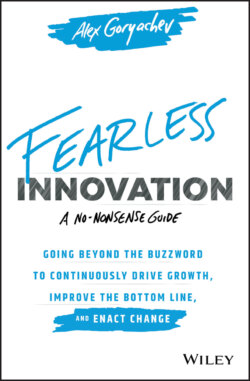Читать книгу Fearless Innovation - Alex Goryachev - Страница 16
Innovating for a Higher Purpose
ОглавлениеThe innovation-change cycle can be illustrated by the work of Abraham Maslow. If you’re not familiar with Maslow, he was a twentieth-century American psychologist, best known for developing the concept of Maslow’s hierarchy of needs, typically depicted as a pyramid consisting of five levels that address our material and immaterial human needs.
At the bottom level, we have our most basic physiological needs, such as food, shelter, and clothing. The next level up is safety, covering aspects like personal safety and financial security. Level three is that of friendship, family, and a sense of connection, known as the love and belonging level. The fourth level is esteem, including self-esteem, status, and the feeling of accomplishment. And the top level is self-actualization, basically a level that’s all about being the best people we can be, focused on a sense of morality, personal development, and creativity.
This pyramid shows that as one set of needs are met, others arise, and they always will until we reach the self-actualization zone. And though self-actualization is an excellent concept we should all strive for, it seems that for most people, more material desires will continue to replace any that have been met. (I’ll leave whether or not this is an endless cycle to the psychologists and real therapists.) The point is that, depending on time, place, and circumstances, fulfilling all of these needs presents challenges, especially as we move on up the pyramid.
Maslow’s hierarchy can actually be seen as one of innovation in practice. Innovation solves the issues society faces at each level, meeting demands of our physical safety, human collaboration, and social, cultural, and economic change. It’s a forward-looking mindset and attitude, and it can’t exist on its own, but only in relation to the world around us.
This concept can be illustrated by observing the earth at night. In 2017, NASA scientists released new global maps of the earth after the sun goes down around the world.32 Produced almost every decade for the past twenty-five years, these “night light” maps contribute to a better understanding of our world, including changing economic, social, and environmental implications. When looking at the map, the first thing that jumps out is how dark it actually is throughout much of the globe despite a number of bright clusters. The dark areas are mostly spread out in developing countries, many of which have yet to begin experiencing the effects of the Fourth Industrial Revolution.
While some of us are living in smart houses, with amenities like connected irrigation systems, and are sending off cotton swabs of DNA to learn about our personal genomics, almost half of the world has yet to get connected to the Internet.33 While we’re playing on our smartphones, swiping left on Tinder, or watching YouTube videos, one-third of the world population lacks access to clean water34 and half of the world population doesn’t have access to basic healthcare.35
I don’t make these comparisons to be flip or to embarrass or shame anyone—there’s nothing wrong with taking advantage of the Fourth Industrial Revolution’s opportunities to pursue a variety of experiences. I bring these issues up because I firmly believe that we all have a responsibility to improve the living conditions for people everywhere. Such improvement can only happen through innovation and economic opportunity. Organizations that are leading this change by investing in making the world a better place end up benefiting more than just their shareholders—they benefit everyone.
